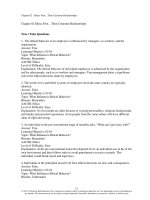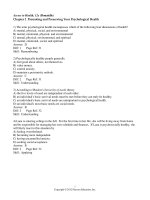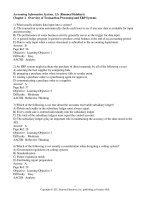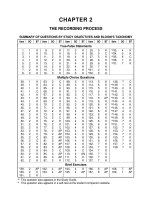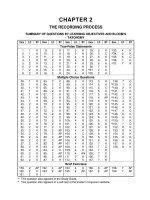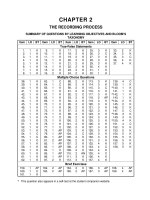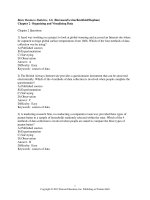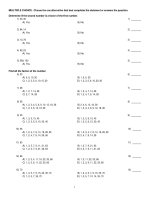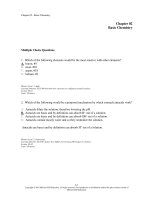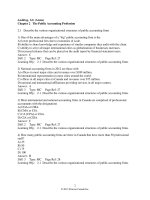Accounting principles 12th edition weygandt test bank
Bạn đang xem bản rút gọn của tài liệu. Xem và tải ngay bản đầy đủ của tài liệu tại đây (580.09 KB, 73 trang )
CHAPTER 2
THE RECORDING PROCESS
SUMMARY OF QUESTIONS BY LEARNING OBJECTIVES AND BLOOM’S
TAXONOMY
Item
LO
BT
Item
LO
BT
Item
LO
BT
Item
LO
BT
3
3
3
3
3
4
1
1
K
C
K
K
K
K
K
K
113.
114.
115.
116.
117.
118.
119.
120.
121.
122.
123.
124.
125.
126.
127.
128.
129.
130.
131.
132.
133.
134.
135.
136.
137.
3
3
3
3
3
2
3
3
3
3
3
3
3
3
3
3
3
3
3
4
4
4
4
4
4
166.
167.
3
3
Item
LO
BT
33.
34.
35.
36.
37.
2
3
3
4
4
K
K
C
K
K
K
K
C
K
K
AP
K
K
K
K
K
K
K
K
K
K
K
K
K
K
C
K
C
K
K
138.
139.
st
140.
141.
st
142.
143.
st
144.
145.
146.
147.
st
148.
149.
st
150.
151.
152.
153.
154.
155.
156.
157.
158.
4
1
1
1
1
1
2
2
2
2
3
3
4
4
5
5
5
5
5
5
5
C
K
K
K
K
K
K
K
K
C
K
K
K
C
K
K
K
K
K
K
K
AP
AP
168.
169.
4
4
AP
AP
True-False Statements
1.
2.
3.
4.
5.
6.
7.
8.
1
1
1
1
1
1
1
1
K
K
K
K
K
K
K
K
9.
10.
11.
12.
13.
14.
15.
16.
1
1
1
1
1
1
2
2
K
K
K
K
K
K
K
K
17.
18.
19.
20.
21.
22.
23.
24.
2
2
2
2
2
2
2
2
K
K
K
K
K
K
K
K
25.
26.
27.
28.
29.
30.
31.
32.
Multiple Choice Questions
38.
39.
40.
41.
42.
43.
44.
45.
46.
47.
48.
49.
50.
51.
52.
53.
54.
55.
56.
57.
58.
59.
60.
61.
62.
1
1
1
1
1
1
1
1
1
1
1
1
1
1
1
1
1
1
1
1
1
1
1
1
1
K
K
K
C
K
K
K
K
K
K
K
K
K
K
K
K
C
C
C
K
K
K
K
K
K
63.
64.
65.
66.
67.
68.
69.
70.
71.
72.
73.
74.
75.
76.
77.
78.
79.
80.
81.
82.
83.
84.
85.
86.
87.
1
1
1
1
1
1
1
1
1
1
1
1
1
1
1
1
1
1
2
1
1
1
1
1
2
C
C
K
K
K
K
K
C
K
K
K
C
K
K
C
AP
AP
AP
AP
AP
AP
C
AP
AP
K
88.
89.
90.
91.
92.
93.
94.
95.
96.
97.
98.
99.
100.
101.
102.
103.
104.
105.
106.
107.
108.
109.
110.
111.
112.
2
2
2
2
2
2
2
2
2
2
2
2
2
2
2
2
2
2
2
2
2
2
2
3
3
K
K
K
K
C
K
K
K
K
K
K
K
K
K
K
K
C
K
K
K
K
C
AN
K
K
Brief Exercises
159.
160.
161.
st
1
1
1
AP
C
K
162.
163.
2
2
AP
AP
164.
165.
2
2
K
AP
This question also appears in a self-test at the student companion website.
2-2
Test Bank for Accounting Principles, Twelfth Edition
SUMMARY OF QUESTIONS BY LEARNING OBJECTIVES AND BLOOM’S
TAXONOMY
Exercises
170.
171.
172.
173.
174.
1
1
1
1
1
AP
C
C
C
C
175.
176.
177.
178.
179.
1
1
1
1
2
C
C
C
C
AP
180.
181.
182.
183.
184.
1
2
2
2
3
C
AP
C
AP
AP
185.
186.
187.
188.
189.
4
3
3
4
4
AP
AN
AP
AN
AN
190.
191.
192.
193.
4
4
4
4
AP
AP
AP
AN
2
2
K
K
202.
203.
3
4
K
K
2, 3
1
1
S
E
S
Completion Statements
194.
195.
1
1
K
K
196.
197.
1
1
K
K
198.
199.
2
2
K
K
200.
201.
Short-Answer Essay
205.
206.
3
207.
1
1
1
C
C
S
208.
209.
210.
4
2
2
AN
S
C
211.
212.
213.
2
3
3
C
C
S
214.
215.
216.
SUMMARY OF LEARNING OBJECTIVES BY QUESTION TYPE
Item
Type
Item
Type
Item
1.
2.
3.
4.
5.
6.
7.
8.
9.
10.
11.
12.
13.
14.
TF
TF
TF
TF
TF
TF
TF
TF
TF
TF
TF
TF
TF
TF
31.
32.
38.
39.
40.
41.
42.
43.
44.
45.
46.
47.
48.
49.
TF
TF
MC
MC
MC
MC
MC
MC
MC
MC
MC
MC
MC
MC
50.
51.
52.
53.
54.
55.
56.
57.
58.
59.
60.
61.
62.
63.
15.
16.
17.
18.
19.
20.
21.
22.
23.
TF
TF
TF
TF
TF
TF
TF
TF
TF
24.
33.
81.
87.
88.
89.
90.
91.
92.
TF
TF
MC
MC
MC
MC
MC
MC
MC
93.
94.
95.
96.
97.
98.
99.
100.
101.
Type
Item
Type
Item
Type
Item
Type
Item
Type
MC
MC
MC
MC
MC
MC
MC
MC
MC
MC
MC
MC
MC
BE
160.
161.
170.
171.
172.
173.
174.
175.
176.
177.
178.
180.
194.
195.
BE
BE
Ex
Ex
Ex
Ex
Ex
Ex
Ex
Ex
Ex
Ex
C
C
196.
197.
205.
206.
207.
215.
216.
C
C
SA
SA
SA
SA
SA
MC
MC
MC
MC
MC
BE
BE
BE
BE
179.
181.
182.
183.
198.
199.
200.
201.
209.
Ex
Ex
Ex
Ex
C
C
C
C
SA
210.
211.
214.
SA
SA
SA
Learning Objective 1
MC
64. MC
78.
MC
65. MC
79.
MC
66. MC
80.
MC
67. MC
82.
MC
68. MC
83.
MC
69. MC
84.
MC
70. MC
85.
MC
71. MC
86.
MC
72. MC
139.
MC
73. MC
140.
MC
74. MC
141.
MC
75. MC
142.
MC
76. MC
143.
MC
77. MC
159.
Learning Objective 2
MC
102. MC
118.
MC
103. MC
144.
MC
104. MC
145.
MC
105. MC
146.
MC
106. MC
147.
MC
107. MC
162.
MC
108. MC
163.
MC
109. MC
164.
MC
110. MC
165.
FOR INSTRUCTOR USE ONLY
The Recording Process
2-3
SUMMARY OF LEARNING OBJECTIVES BY QUESTION TYPE
25.
26.
27.
28.
29.
34.
35.
TF
TF
TF
TF
TF
TF
TF
111.
112.
113.
114.
115.
116.
117.
MC
MC
MC
MC
MC
MC
MC
119.
120.
121.
122.
123.
124.
125.
30.
36.
37.
132.
133.
TF
TF
TF
MC
MC
134.
135.
136.
137.
138.
MC
MC
MC
MC
MC
150.
151.
168.
169.
185.
152.
MC
153.
MC
154.
Note: TF = True-False
MC = Multiple Choice
Learning Objective 3
MC
126. MC
149.
MC
127. MC
166.
MC
128. MC
167.
MC
129. MC
184.
MC
130. MC
186.
MC
131. MC
187.
MC
148. MC
202.
Learning Objective 4
MC
188. Ex
193.
MC
189. Ex
203.
BE
190. Ex
208.
BE
191. Ex
193.
Ex
192. Ex
Learning Objective 5
MC
155. MC
156.
MC
BE
BE
Ex
Ex
Ex
C
212.
213.
214.
SA
SA
SA
157.
MC
Ex
C
SA
Ex
MC
BE = Brief Exercise
Ex = Exercise
158.
MC
C = Completion
SA = Short-Answer Essay
The chapter also contains one set of ten Matching questions and six Short-Answer Essay
questions. A summary table of all learning outcomes, including AACSB, AICPA, and IMA
professional standards, is available on the Weygandt Accounting Principles 12e instructor web
site.
CHAPTER LEARNING OBJECTIVES
1. Describe how accounts, debits, and credits are used to record business transactions .
An account is a record of increases and decreases in specific asset, liability, and owner’s
equity items. The terms debit and credit are synonymous with left and right. Assets, drawings,
and expenses are increased by debits and decreased by credits. Liabilities, owner’s capital,
and revenues are increased by credits and decreased by debits.
2. Indicate how a journal is used in the recording process. The basic steps in the recording
process are (a) analyze each transaction for its effects on the accounts, (b) enter the
transaction information in a journal, and (c) transfer the journal information to the appropriate
accounts in the ledger. The initial accounting record of a transaction is entered in a journal
before the data are entered in the accounts. A journal (a) discloses in one place the complete
effects of a transaction, (b) provides a chronological record of transactions, and (c) prevents
or locates errors because the debit and credit amounts for each entry can be easily
compared.
3. Explain how a ledger and posting help in the recording process. The ledger is the entire
group of accounts maintained by a company. The ledger provides the balance in each of the
accounts as well as keeps track of changes in these balances. Posting is the transfer of
journal entries to the ledger accounts. This phase of the recording process accumulates the
effects of journalized transactions in the individual accounts.
4. Prepare a trial balance. A trial balance is a list of accounts and their balances at a given
time. Its primary purpose is to prove the equality of debits and credits after posting. A trial
balance also uncovers errors in journalizing and posting and is useful in preparing financial
statements.
FOR INSTRUCTOR USE ONLY
2-4
Test Bank for Accounting Principles, Twelfth Edition
TRUE-FALSE STATEMENTS
1.
A new account is opened for each transaction entered into by a business firm.
Ans: F LO1 BT: K Difficulty: Easy TOT: .5 min. AACSB: RT AICPA BB: CT AICPA FN: Reporting
2.
The recording process becomes more efficient and informative if all transactions are
recorded in one account.
Ans: F LO1 BT: K Difficulty: Easy TOT: .5 min. AACSB: RT AICPA BB: CT AICPA FN: Reporting
3.
When the volume of transactions is large, recording them in tabular form is more efficient
than using journals and ledgers.
Ans: F LO1 BT: K Difficulty: Easy TOT: .5 min. AACSB: RT AICPA BB: CT AICPA FN: Reporting
4.
An account is often referred to as a T-account because of the way it is constructed.
Ans: T LO1 BT: K Difficulty: Easy TOT: .5 min. AACSB: RT AICPA BB: CT AICPA FN: Reporting
5.
A debit to an account indicates an increase in that account.
Ans: F LO1 BT: K Difficulty: Easy TOT: .5 min. AACSB: RT AICPA BB: CT AICPA FN: Reporting
6.
If a revenue account is credited, the revenue account is increased.
Ans: T LO1 BT: K Difficulty: Easy TOT: .5 min. AACSB: RT AICPA BB: CT AICPA FN: Reporting
7.
The normal balance of all accounts is a debit.
Ans: F LO1 BT: K Difficulty: Easy TOT: .5 min. AACSB: RT AICPA BB: CT AICPA FN: Reporting
8.
Debit and credit can be interpreted to mean increase and decrease, respectively.
Ans: F LO1 BT: K Difficulty: Easy TOT: .5 min. AACSB: RT AICPA BB: CT AICPA FN: Reporting
9.
The double-entry system of accounting refers to the placement of a double line at the end
of a column of figures.
Ans: F LO1 BT: K Difficulty: Easy TOT: .5 min. AACSB: RT AICPA BB: CT AICPA FN: Reporting
10.
A credit balance in a liability account indicates that an error in recording has occurred.
Ans: F LO1 BT: K Difficulty: Easy TOT: .5 min. AACSB: RT AICPA BB: CT AICPA FN: Reporting
11.
The drawing account is a subdivision of the owner’s capital account and appears as an
expense on the income statement.
Ans: F LO1 BT: K Difficulty: Easy TOT: .5 min. AACSB: RT AICPA BB: CT AICPA FN: Reporting
12.
Revenues are a subdivision of owner’s capital.
Ans: T LO1 BT: K Difficulty: Easy TOT: .5 min. AACSB: RT AICPA BB: CT AICPA FN: Reporting
13.
Under the double-entry system, revenues must always equal expenses.
Ans: F LO1 BT: K Difficulty: Easy TOT: .5 min. AACSB: RT AICPA BB: CT AICPA FN: Reporting
14.
Transactions are entered in the ledger first and then they are analyzed in terms of their
effect on the accounts.
Ans: F LO1 BT: K Difficulty: Easy TOT: .5 min. AACSB: RT AICPA BB: CT AICPA FN: Reporting
15.
Business documents can provide evidence that a transaction has occurred.
Ans: T LO2 BT: K Difficulty: Easy TOT: .5 min. AACSB: RT AICPA BB: CT AICPA FN: Reporting
16.
Each transaction must be analyzed in terms of its effect on the accounts before it can be
recorded in a journal.
Ans: T LO2 BT: K Difficulty: Easy TOT: .5 min. AACSB: RT AICPA BB: CT AICPA FN: Reporting
FOR INSTRUCTOR USE ONLY
The Recording Process
17.
2-5
Transactions are entered in the ledger accounts and then transferred to journals.
Ans: F LO2 BT: K Difficulty: Easy TOT: .5 min. AACSB: RT AICPA BB: CT AICPA FN: Reporting
18.
All business transactions must be entered first in the general ledger.
Ans: F LO2 BT: K Difficulty: Easy TOT: .5 min. AACSB: RT AICPA BB: CT AICPA FN: Reporting
19.
A simple journal entry requires only one debit to an account and one credit to an account.
Ans: T LO2 BT: K Difficulty: Easy TOT: .5 min. AACSB: RT AICPA BB: CT AICPA FN: Reporting
20.
A compound journal entry requires several debits to one account and several credits to
one account.
Ans: F LO2 BT: K Difficulty: Easy TOT: .5 min. AACSB: RT AICPA BB: CT AICPA FN: Reporting
21.
Transactions are recorded in alphabetic order in a journal.
Ans: F LO2 BT: K Difficulty: Easy TOT: .5 min. AACSB: RT AICPA BB: CT AICPA FN: Reporting
22.
A journal is also known as a book of original entry.
Ans: T LO2 BT: K Difficulty: Easy TOT: .5 min. AACSB: RT AICPA BB: CT AICPA FN: Reporting
23.
The complete effect of a transaction on the accounts is disclosed in the journal.
Ans: T LO2 BT: K Difficulty: Easy TOT: .5 min. AACSB: RT AICPA BB: CT AICPA FN: Reporting
24.
The account titles used in journalizing transactions need not be identical to the account
titles in the ledger.
Ans: F LO2 BT: K Difficulty: Easy TOT: .5 min. AACSB: RT AICPA BB: CT AICPA FN: Reporting
25.
The chart of accounts is a special ledger used in accounting systems.
Ans: F LO3 BT: K Difficulty: Easy TOT: .5 min. AACSB: RT AICPA BB: CT AICPA FN: Reporting
26.
A general ledger should be arranged in the order in which accounts are presented in the
financial statements, beginning with the balance sheet accounts.
Ans: T LO3 BT:C K Difficulty: Easy TOT: .5 min. AACSB: RT AICPA BB: CT AICPA FN: Reporting
27.
The number and types of accounts used by different business enterprises are the same if
generally accepted accounting principles are being followed by the enterprises.
Ans: F LO3 BT: K Difficulty: Easy TOT: .5 min. AACSB: RT AICPA BB: CT AICPA FN: Reporting
28.
Posting is the process of proving the equality of debits and credits in the trial balance.
Ans: F LO3 BT: K Difficulty: Easy TOT: .5 min. AACSB: RT AICPA BB: CT AICPA FN: Reporting
29.
After a transaction has been posted, the reference column in the journal should not be
blank.
Ans: T LO3 BT: K Difficulty: Easy TOT: .5 min. AACSB: RT AICPA BB: CT AICPA FN: Reporting
30.
A trial balance does not prove that all transactions have been recorded or that the ledger
is correct.
Ans: T LO4 BT: K Difficulty: Easy TOT: .5 min. AACSB: RT AICPA BB: CT AICPA FN: Reporting
31.
The double-entry system is a logical method for recording transactions and results in
equal amounts for debits and credits for each transaction.
Ans: T LO1 BT: K Difficulty: Easy TOT: .5 min. AACSB: RT AICPA BB: CT AICPA FN: Reporting
FOR INSTRUCTOR USE ONLY
Test Bank for Accounting Principles, Twelfth Edition
2-6
32.
The normal balance of an expense is a credit.
Ans: F LO1 BT: K Difficulty: Easy TOT: .5 min. AACSB: RT AICPA BB: CT AICPA FN: Reporting
33.
The journal provides a chronological record of transactions.
Ans: T LO2 BT: K Difficulty: Easy TOT: .5 min. AACSB: RT AICPA BB: CT AICPA FN: Reporting
34.
The ledger is merely a bookkeeping device and therefore does not provide much useful
data for management.
Ans: F LO3 BT: K Difficulty: Easy TOT: .5 min. AACSB: RT AICPA BB: CT AICPA FN: Reporting
35.
The chart of accounts is a listing of the accounts and the account numbers which identify
their location in the ledger.
Ans: T LO3 BT: C Difficulty: Easy TOT: .5 min. AACSB: RT AICPA BB: CT AICPA FN: Reporting
36.
The primary purpose of a trial balance is to prove the mathematical equality of the debits
and credits after posting.
Ans: T LO4 BT: K Difficulty: Easy TOT: .5 min. AACSB: RT AICPA BB: CT AICPA FN: Reporting
37.
The trial balance will not balance when incorrect account titles are used in journalizing or
posting.
Ans: F LO4 BT: K Difficulty: Easy TOT: .5 min. AACSB: RT AICPA BB: CT AICPA FN: Reporting
Answers to True-False Statements
Item
1.
2.
3.
4.
5.
6.
Ans.
F
F
F
T
F
T
Item
7.
8.
9.
10.
11.
12.
Ans.
F
F
F
F
F
T
Item
13.
14.
15.
16.
17.
18.
Ans.
F
F
T
T
F
F
Item
19.
20.
21.
22.
23.
24.
Ans.
T
F
F
T
T
F
Item
Ans.
25.
26.
27.
28.
29.
30.
FOR INSTRUCTOR USE ONLY
F
T
F
F
T
T
Item
31.
32.
33.
34.
35.
36.
Ans.
T
F
T
F
T
T
Item
37.
Ans.
F
The Recording Process
2-7
MULTIPLE CHOICE QUESTIONS
38.
An account consists of
a. one part.
b. two parts.
c. three parts.
d. four parts.
Ans: c LO1 BT: K Difficulty: Easy TOT: 1 min. AACSB: RT AICPA BB: CT AICPA FN: Reporting
39.
The left side of an account is
a. blank.
b. a description of the account.
c. the debit side.
d. the balance of the account.
Ans: c LO1 BT: K Difficulty: Easy TOT: 1 min. AACSB: RT AICPA BB: CT AICPA FN: Reporting
40.
Which one of the following is not a part of an account?
a. Credit side
b. Trial balance
c. Debit side
d. Title
Ans: b LO1 BT: K Difficulty: Easy TOT: 1 min. AACSB: RT AICPA BB: CT AICPA FN: Reporting
41.
An account is a part of the financial information system and is described by all except
which one of the following?
a. An account has a debit and credit side.
b. An account is a source document.
c. An account may be part of a manual or a computerized accounting system.
d. An account has a title.
Ans: b LO1 BT: C Difficulty: Easy TOT: 1 min. AACSB: RT AICPA BB: CT AICPA FN: Reporting
42.
The right side of an account
a. is the correct side.
b. reflects all transactions for the accounting period.
c. shows all the balances of the accounts in the system.
d. is the credit side.
Ans: d LO1 BT: K Difficulty: Easy TOT: 1 min. AACSB: RT AICPA BB: CT AICPA FN: Reporting
43.
An account consists of
a. a title, a debit balance, and a credit balance.
b. a title, a left side, and a debit balance.
c. a title, a debit side, and a credit side.
d. a title, a right side, and a debit balance.
Ans: c LO1 BT: K Difficulty: Easy TOT: 1 min. AACSB: RT AICPA BB: CT AICPA FN: Reporting
44.
A T-account is
a. a way of depicting the basic form of an account.
b. what the computer uses to organize bytes of information.
c. a special account used instead of a trial balance.
d. used for accounts that have both a debit and credit balance.
Ans: a LO1 BT: K Difficulty: Easy TOT: 1 min. AACSB: RT AICPA BB: CT AICPA FN: Reporting
FOR INSTRUCTOR USE ONLY
2-8
45.
Test Bank for Accounting Principles, Twelfth Edition
Credits
a. decrease both assets and liabilities.
b. decrease assets and increase liabilities.
c. increase both assets and liabilities.
d. increase assets and decrease liabilities.
Ans: b LO1 BT: K Difficulty: Easy TOT: 1 min. AACSB: RT AICPA BB: CT AICPA FN: Reporting
46.
A debit to an asset account indicates
a. an error.
b. a credit was made to a liability account.
c. a decrease in the asset.
d. an increase in the asset.
Ans: d LO1 BT: K Difficulty: Easy TOT: 1 min. AACSB: RT AICPA BB: CT AICPA FN: Reporting
47.
The normal balance of any account is the
a. left side.
b. right side.
c. side which increases that account.
d. side which decreases that account.
Ans: c LO1 BT: K Difficulty: Easy TOT: 1 min. AACSB: RT AICPA BB: CT AICPA FN: Reporting
48.
The double-entry system requires that each transaction must be recorded
a. in at least two different accounts.
b. in two sets of books.
c. in a journal and in a ledger.
d. first as a revenue and then as an expense.
Ans: a LO1 BT: K Difficulty: Easy TOT: 1 min. AACSB: RT AICPA BB: CT AICPA FN: Reporting
49.
A credit is not the normal balance for which account listed below?
a. Capital account
b. Revenue account
c. Liability account
d. Owner’s Drawings account
Ans: d LO1 BT: K Difficulty: Easy TOT: 1 min. AACSB: RT AICPA BB: CT AICPA FN: Reporting
50.
Which one of the following could represent the expanded basic accounting equation?
a. Assets = Liabilities + Owner’s Capital + Owner’s Drawings – Revenue – Expenses.
b. Assets + Owner’s Drawings + Expenses = Liabilities + Owner’s Capital + Revenues.
c. Assets – Liabilities – Owner’s Drawings = Owner’s Capital + Revenues – Expenses.
d. Assets = Revenues + Expenses – Liabilities.
Ans: b LO1 BT: K Difficulty: Easy TOT: 1 min. AACSB: RT AICPA BB: CT AICPA FN: Reporting
FOR INSTRUCTOR USE ONLY
The Recording Process
51.
Which of the following correctly identifies normal balances of accounts?
a. Assets
Debit
Liabilities
Credit
Owner’s Capital
Credit
Revenues
Debit
Expenses
Credit
b. Assets
Liabilities
Owner’s Capital
Revenues
Expenses
Debit
Credit
Credit
Credit
Credit
c. Assets
Liabilities
Owner’s Capital
Revenues
Expenses
Credit
Debit
Debit
Credit
Debit
d. Assets
Liabilities
Owner’s Capital
Revenues
Expenses
Debit
Credit
Credit
Credit
Debit
Ans: d LO1 BT: K Difficulty: Easy TOT: 1 min. AACSB: RT AICPA BB: CT AICPA FN: Reporting
52.
The best interpretation of the word credit is the
a. offset side of an account.
b. increase side of an account.
c. right side of an account.
d. decrease side of an account.
Ans: c LO1 BT: K Difficulty: Easy TOT: 1 min. AACSB: RT AICPA BB: CT AICPA FN: Reporting
53.
In recording an accounting transaction in a double-entry system
a. the number of debit accounts must equal the number of credit accounts.
b. there must always be entries made on both sides of the accounting equation.
c. the amount of the debits must equal the amount of the credits.
d. there must only be two accounts affected by any transaction.
Ans: c LO1 BT: K Difficulty: Easy TOT: 1 min. AACSB: RT AICPA BB: CT AICPA FN: Reporting
54.
Debits
a. decrease both assets and liabilities.
b. decrease liabilities and increase assets.
c. increase both assets and liabilities.
d. increase liabilities and decrease assets.
Ans: b LO1 BT: C Difficulty: Easy TOT: 1 min. AACSB: RT AICPA BB: CT AICPA FN: Reporting
55.
A debit is not the normal balance for which account listed below?
a. Owner’s Drawings
b. Cash
c. Accounts Receivable
d. Service Revenue
Ans: d LO1 BT: C Difficulty: Easy TOT: 1 min. AACSB: RT AICPA BB: CT AICPA FN: Reporting
FOR INSTRUCTOR USE ONLY
2-9
2 - 10
56.
Test Bank for Accounting Principles, Twelfth Edition
An accountant has debited an asset account for $1,400 and credited a liability account for
$500. What can be done to complete the recording of the transaction?
a. Nothing further must be done.
b. Debit an owner’s equity account for $900.
c. Debit another asset account for $900.
d. Credit a different asset account for $900.
Ans: d LO1 BT: C Difficulty: Easy TOT: 1 min. AACSB: RT AICPA BB: CT AICPA FN: Reporting
57.
An accountant has debited an asset account for $1,300 and credited a liability account for
$600. Which of the following would be an incorrect way to complete the recording of the
transaction?
a. Credit an asset account for $700.
b. Credit another liability account for $700.
c. Credit an owner’s equity account for $700.
d. Debit an owner’s equity account for $700.
Ans: d LO1 BT: K Difficulty: Easy TOT: 1 min. AACSB: RT AICPA BB: CT AICPA FN: Reporting
58.
Which of the following is not true of the terms debit and credit?
a. They can be abbreviated as Dr. and Cr.
b. They can be interpreted to mean increase and decrease.
c. They can be used to describe the balance of an account.
d. They can be interpreted to mean left and right.
Ans: b LO1 BT: K Difficulty: Easy TOT: 1 min. AACSB: RT AICPA BB: CT AICPA FN: Reporting
59.
An account will have a credit balance if the
a. credits exceed the debits.
b. first transaction entered was a credit.
c. debits exceed the credits.
d. last transaction entered was a credit.
Ans: a LO1 BT: K Difficulty: Easy TOT: 1 min. AACSB: RT AICPA BB: CT AICPA FN: Reporting
60.
For the basic accounting equation to stay in balance, each transaction recorded must
a. affect two or less accounts.
b. affect two or more accounts.
c. always affect exactly two accounts.
d. affect the same number of asset and liability accounts.
Ans: b LO1 BT: K Difficulty: Easy TOT: 1 min. AACSB: RT AICPA BB: CT AICPA FN: Reporting
61.
Which of the following statements is true?
a. Debits increase assets and increase liabilities.
b. Credits decrease assets and decrease liabilities.
c. Credits decrease assets and increase liabilities.
d. Debits decrease liabilities and decrease assets.
Ans: c LO1 BT: K Difficulty: Easy TOT: 1 min. AACSB: RT AICPA BB: CT AICPA FN: Reporting
62.
Assets normally show
a. credit balances.
b. debit balances.
c. debit and credit balances.
d. debit or credit balances.
Ans: b LO1 BT: K Difficulty: Easy TOT: 1 min. AACSB: RT AICPA BB: CT AICPA FN: Reporting
FOR INSTRUCTOR USE ONLY
The Recording Process
63.
An awareness of the normal balances of accounts would help you spot which of the
following as an error in recording?
a. A debit balance in the owner’s drawings account
b. A credit balance in an expense account
c. A credit balance in a liabilities account
d. A credit balance in a revenue account
Ans: b LO1 BT: C Difficulty: Easy TOT: 1 min. AACSB: RT AICPA BB: CT AICPA FN: Reporting
64.
If a company has overdrawn its bank balance, then
a. its cash account will show a debit balance.
b. its cash account will show a credit balance.
c. the cash account debits will exceed the cash account credits.
d. it cannot be detected by observing the balance of the cash account.
Ans: b LO1 BT: C Difficulty: Easy TOT: 1 min. AACSB: RT AICPA BB: CT AICPA FN: Reporting
65.
Which account below is not a subdivision of owner’s equity?
a. Owner’s Drawings
b. Revenues
c. Expenses
d. Liabilities
Ans: d LO1 BT: K Difficulty: Easy TOT: 1 min. AACSB: RT AICPA BB: CT AICPA FN: Reporting
66.
When an owner makes a withdrawal
a. it doesn’t have to be cash, it could be another asset.
b. the owner’s drawings account will be increased with a credit.
c. the owner’s capital account will be directly increased with a debit.
d. the owner’s drawings account will be decreased with a debit.
Ans: a LO1 BT: K Difficulty: Easy TOT: 1 min. AACSB: RT AICPA BB: CT AICPA FN: Reporting
67.
The owner’s drawings account
a. appears on the income statement along with the expenses of the business.
b. must show transactions every accounting period.
c. is increased with debits and decreased with credits.
d. is not a proper subdivision of owner’s equity.
Ans: c LO1 BT: K Difficulty: Easy TOT: 1 min. AACSB: RT AICPA BB: CT AICPA FN: Reporting
68.
Which of the following statements is not true?
a. Expenses increase owner’s equity.
b. Expenses have normal debit balances.
c. Expenses decrease owner’s equity.
d. Expenses are a negative factor in the computation of net income.
Ans: a LO1 BT: K Difficulty: Easy TOT: 1 min. AACSB: RT AICPA BB: CT AICPA FN: Reporting
69.
2 - 11
A credit to a liability account
a. indicates an increase in the amount owed to creditors.
b. indicates a decrease in the amount owed to creditors.
c. is an error.
d. must be accompanied by a debit to an asset account.
Ans: a LO1 BT: K Difficulty: Easy TOT: 1 min. AACSB: RT AICPA BB: CT AICPA FN: Reporting
FOR INSTRUCTOR USE ONLY
2 - 12
70.
Test Bank for Accounting Principles, Twelfth Edition
In the first month of operations, the total of the debit entries to the cash account amounted
to $1,400 and the total of the credit entries to the cash account amounted to $800. The
cash account has a(n)
a. $800 credit balance.
b. $1,400 debit balance.
c. $600 debit balance.
d. $600 credit balance.
Ans: c LO1 BT: C Difficulty: Easy TOT: 1 min. AACSB: RT AICPA BB: CT AICPA FN: Reporting
Solution: $1,400 $800 = $600
71.
Phast Mail Service purchased equipment for $2,000. Phast paid $500 in cash and signed
a note for the balance. Phast debited the Equipment account, credited Cash and
a. nothing further must be done.
b. debited the Capital account for $1,500.
c. credited another asset account for $500.
d. credited a liability account for $1,500.
Ans: d LO1 BT: K Difficulty: Easy TOT: 1 min. AACSB: RT AICPA BB: CT AICPA FN: Reporting
Solution: $2,000 $500 = $1,500
72.
Madrid Industries purchased supplies for $1,200. They paid $500 in cash and agreed to
pay the balance in 30 days. The journal entry to record this transaction would include a
debit to an asset account for $1,200, a credit to a liability account for $700. Which of the
following would be the correct way to complete the recording of the transaction?
a. Credit an asset account for $500.
b. Credit another liability account for $500.
c. Credit the Capital account for $500.
d. Debit the Capital account for $500.
Ans: a LO1 BT: K Difficulty: Easy TOT: 1 min. AACSB: RT AICPA BB: CT AICPA FN: Reporting
73.
On January 14, Maxine Industries purchased supplies of $900 on account. The entry to
record the purchase will include
a. a debit to Supplies and a credit to Accounts Payable.
b. a debit to Supplies Expense and a credit to Accounts Receivable.
c. a debit to Supplies and a credit to Cash.
d. a debit to Accounts Receivable and a credit to Supplies.
Ans: a LO1 BT: K Difficulty: Easy TOT: 1 min. AACSB: RT AICPA BB: CT AICPA FN: Reporting
74.
On June 1, 2016, Barcelona Inc. reported a cash balance of $11,000. During June,
Barcelona made deposits of $3,000 and made disbursements totalling $9,000. What is the
cash balance at the end of June?
a. $5,000 debit balance
b. $14,000 debit balance
c. $5,000 credit balance
d. $4,000 credit balance
Ans: a LO1 BT: C Difficulty: Easy TOT: 1 min. AACSB: RT AICPA BB: CT AICPA FN: Reporting
Solution: $11,000 $3,000 $9,000 = $5,000
FOR INSTRUCTOR USE ONLY
The Recording Process
75.
2 - 13
At January 1, 2016, Croc Industries reported owner’s capital of $140,000. During 2016,
Croc had a net loss of $30,000 and owner drawings of $15,000. At December 31, 2016,
the amount of owner’s capital is
a. $ 95,000.
b. $110,000.
c. $125,000.
d. $155,000.
Ans: a LO1 BT: K Difficulty: Easy TOT: 1 min. AACSB: RT AICPA BB: CT AICPA FN: Reporting
Solution: $140,000 $30,000 $15,000 = $95,000
76.
Boise Co. pays its employees twice a month, on the 7th and the 21st. On June 21, Boise
Co. paid employee salaries of $6,000. This transaction would
a. increase owner’s equity by $6,000.
b. decrease the balance in Salaries and Wages Expense by $6,000.
c. decrease net income for the month by $6,000.
d. be recorded by a $6,000 debit to Salaries and Wages Payable and a $6,000 credit to
Salaries and Wages Expense.
Ans: c LO1 BT: K Difficulty: Medium TOT: 1 min. AACSB: RT AICPA BB: CT AICPA FN: Reporting
77.
In the first month of operations for Pendleton Industries, the total of the debit entries to the
cash account amounted to $33,000 ($13,000 investment by the owner and revenues of
$20,000). The total of the credit entries to the cash account amounted to $21,000
(purchase of equipment $8,000 and payment of expenses $13,000). At the end of the
month, the cash account has a(n)
a. $5,000 credit balance.
b. $5,000 debit balance.
c. $12,000 debit balance.
d. $12,000 credit balance.
Ans: c LO1 BT: C Difficulty: Easy TOT: 1 min. AACSB: RT AICPA BB: CT AICPA FN: Reporting
Solution: $33,000 $21,000 = $12,000 debit
78.
Qwik Company showed the following balances at the end of its first year:
Cash
Prepaid insurance
Accounts receivable
Accounts payable
Notes payable
Owner’s Capital
Owner’s Drawings
Revenues
Expenses
$ 8,700
9,400
7,000
5,800
9,400
2,300
1,400
44,000
35,000
What did Qwik Company show as total credits on its trial balance?
a. $52,400
b. $61,500
c. $62,900
d. $70,900
Ans: b LO1 BT: AP Difficulty: Medium TOT: 1.5 min. AACSB: RT AICPA BB: CT AICPA PC: PS
Solution: $5,800 $9,400 $2,300 $44,000 = $61,500
FOR INSTRUCTOR USE ONLY
2 - 14
79.
Test Bank for Accounting Principles, Twelfth Edition
Bertoli Company showed the following balances at the end of its first year:
Cash
Prepaid insurance
Accounts receivable
Accounts payable
Notes payable
Owner’s Capital
Owner’s Drawings
Revenues
Expenses
$ 4,000
7,000
8,000
4,000
7,000
3,000
2,000
32,000
25,000
What did Bertoli Company show as total credits on its trial balance?
a. $14,000
b. $46,000
c. $44,000
d. $48,000
Ans: b LO1 BT: AP Difficulty: Medium TOT: 1.5 min. AACSB: RT AICPA BB: CT AICPA PC: PS
Solution: $4,000 $7,000 $3,000 $32,000 = $46,000
80.
During February 2016, its first month of operations, the owner of Solcist Co. invested cash
of $50,000. Solcist had cash revenues of $16,000 and paid expenses of $21,000.
Assuming no other transactions impacted the cash account, what is the balance in Cash
at February 29?
a. $5,000 credit
b. $5,000 debit
c. $45,000 debit
d. $55,000 debit
Ans: c LO1 BT: AP Difficulty: Easy TOT: 1 min. AACSB: RT AICPA BB: CT AICPA FN: Reporting
Solution: $50,000 $16,000 $21,000 = $45,000
81.
At January 31, 2016, the balance in Bigelow Inc.’s supplies account was $780. During
February, Bigelow purchased supplies of $900 and used supplies of $1,150. At the end of
February, the balance in the supplies account should be
a. $530 debit.
b. $1,030 debit.
c. $530 credit.
d. $830 debit.
Ans: a LO2 BT: AP Difficulty: Easy TOT: 1 min. AACSB: RT AICPA BB: CT AICPA FN: Reporting
Solution: $780 $900 $1,150 = $530 debit
82.
At December 1, 2016, Dubois Company’s accounts receivable balance was $1,300.
During December, Dubois had credit sales of $7,400 and collected accounts receivable of
$6,000. At December 31, 2016, the accounts receivable balance is
a. $100 debit.
b. $2,700 debit.
c. $100 credit.
d. $2,700 credit.
Ans: b LO1 BT: AP Difficulty: Easy TOT: 1 min. AACSB: RT AICPA BB: CT AICPA FN: Reporting
Solution: $1,300 $7,400 $6,000 = $2,700 debit
FOR INSTRUCTOR USE ONLY
The Recording Process
83.
2 - 15
At October 1, 2016, Medina Co. had an accounts payable balance of $50,000. During the
month, the company made purchases on account of $35,000 and made payments on
account of $48,000. At October 31, 2016, the accounts payable balance is
a. $37,000.
b. $33,000.
c. $63,000.
d. $133,000.
Ans: a LO1 BT: AP Difficulty: Easy TOT: 1 min. AACSB: RT AICPA BB: CT AICPA FN: Reporting
Solution: $50,000 35,000 $48,000 = $37,000
84.
During 2016, its first year of operations, Aida’s Bakery had revenues of $65,000 and
expenses of $35,000. The business had owner’s drawings of $22,000. What is the amount
of owner’s equity at December 31, 2016?
a. $0
b. $8,000 credit
c. $30,000 credit
d. $22,000 debit
Ans: b LO1 BT: C Difficulty: Medium TOT: 1 min. AACSB: RT AICPA BB: CT AICPA FN: Reporting
Solution: $0 ($65,000 $35,000) $22,000 = $8,000
85.
On July 7, 2016, Rancho Realty Co. performed cash services of $1,900. The entry to
record this transaction would include
a. a debit to Service Revenue of $1,900.
b. a credit to Accounts Receivable of $1,900.
c. a debit to Cash of $1,900.
d. a credit to Accounts Payable of $1,900.
Ans: c LO1 BT: AP Difficulty: Easy TOT: 1 min. AACSB: RT AICPA BB: CT AICPA FN: Reporting
86.
At September 1, 2016, Hotel Suites Co. reported owner’s capital of $147,000. During the
month, Hotel Suites generated revenues of $48,000, incurred expenses of $26,000,
purchased equipment for $5,000 and withdrew cash of $3,000. What is the amount of
owner’s capital at September 30, 2016?
a. $161,000
b. $166,000
c. $169,000
d. $171,000
Ans: b LO1 BT: AP Difficulty: Medium TOT: 1.5 min. AACSB: RT AICPA BB: CT AICPA FN: Reporting
Solution: $147,000 ($48,000 $26,000) $3,000 = $166,000
87.
The final step in the recording process is to
a. analyze each transaction.
b. enter the transaction in a journal.
c. prepare a trial balance.
d. transfer journal information to ledger accounts.
Ans: d LO2 BT: K Difficulty: Easy TOT: 1 min. AACSB: RT AICPA BB: CT AICPA FN: Reporting
FOR INSTRUCTOR USE ONLY
2 - 16
88.
Test Bank for Accounting Principles, Twelfth Edition
The usual sequence of steps in the transaction recording process is:
a. journal analyze ledger.
b. analyze journal ledger.
c. journal ledger analyze.
d. ledger journal analyze.
Ans: b LO2 BT: K Difficulty: Easy TOT: 1 min. AACSB: RT AICPA BB: CT AICPA FN: Reporting
89.
In recording business transactions, evidence that an accounting transaction has taken
place is obtained from
a. business documents.
b. the Internal Revenue Service.
c. the public relations department.
d. the SEC.
Ans: a LO2 BT: K Difficulty: Easy TOT: 1 min. AACSB: RT AICPA BB: CT AICPA FN: Reporting
90.
After a business transaction has been analyzed and entered in the book of original entry,
the next step in the recording process is to transfer the information to
a. the company’s bank.
b. owner’s equity.
c. ledger accounts.
d. financial statements.
Ans: c LO2 BT: K Difficulty: Easy TOT: 1 min. AACSB: RT AICPA BB: CT AICPA FN: Reporting
91.
The first step in the recording process is to
a. prepare financial statements.
b. analyze each transaction for its effect on the accounts.
c. post to a journal.
d. prepare a trial balance.
Ans: b LO2 BT: K Difficulty: Easy TOT: 1 min. AACSB: RT AICPA BB: CT AICPA FN: Reporting
92.
Evidence that would not help with determining the effects of a transaction on the accounts
would be a(n)
a. cash register sales tape.
b. bill.
c. advertising brochure.
d. check.
Ans: c LO2 BT: C Difficulty: Easy TOT: 1 min. AACSB: RT AICPA BB: CT AICPA FN: Reporting
93.
After transaction information has been recorded in the journal, it is transferred to the
a. trial balance.
b. income statement.
c. book of original entry.
d. ledger.
Ans: d LO2 BT: K Difficulty: Easy TOT: 1 min. AACSB: RT AICPA BB: CT AICPA FN: Reporting
FOR INSTRUCTOR USE ONLY
The Recording Process
94.
2 - 17
The usual sequence of steps in the recording process is to analyze each transaction,
enter the transaction in the
a. journal, and transfer the information to the ledger accounts.
b. ledger, and transfer the information to the journal.
c. book of accounts, and transfer the information to the journal.
d. book of original entry, and transfer the information to the journal.
Ans: a LO2 BT: K Difficulty: Easy TOT: 1 min. AACSB: RT AICPA BB: CT AICPA FN: Reporting
95.
The final step in the recording process is to transfer the journal information to the
a. trial balance.
b. financial statements.
c. ledger.
d. file cabinets.
Ans: c LO2 BT: K Difficulty: Easy TOT: 1 min. AACSB: RT AICPA BB: CT AICPA FN: Reporting
96.
The recording process occurs
a. once a year.
b. once a month.
c. repeatedly during the accounting period.
d. infrequently in a manual accounting system.
Ans: c LO2 BT: K Difficulty: Easy TOT: 1 min. AACSB: RT AICPA BB: CT AICPA FN: Reporting
97.
A compound journal entry involves
a. two accounts.
b. three accounts.
c. three or more accounts.
d. four or more accounts.
Ans: c LO2 BT: K Difficulty: Easy TOT: 1 min. AACSB: RT AICPA BB: CT AICPA FN: Reporting
98.
A journal provides
a. the balances for each account.
b. information about a transaction in several different places.
c. a list of all accounts used in the business.
d. a chronological record of transactions.
Ans: d LO2 BT: K Difficulty: Easy TOT: 1 min. AACSB: RT AICPA BB: CT AICPA FN: Reporting
99.
When three or more accounts are required in one journal entry, the entry is referred to as a
a. compound entry.
b. triple entry.
c. multiple entry.
d. simple entry.
Ans: a LO2 BT: K Difficulty: Easy TOT: 1 min. AACSB: RT AICPA BB: CT AICPA FN: Reporting
FOR INSTRUCTOR USE ONLY
2 - 18
100.
Test Bank for Accounting Principles, Twelfth Edition
When two accounts are required in one journal entry, the entry is referred to as a
a. balanced entry.
b. simple entry.
c. posting.
d. nominal entry.
Ans: b LO2 BT: K Difficulty: Easy TOT: 1 min. AACSB: RT AICPA BB: CT AICPA FN: Reporting
101.
Another name for a journal is
a. listing.
b. book of original entry.
c. book of accounts.
d. book of source documents.
Ans: b LO2 BT: K Difficulty: Easy TOT: 1 min. AACSB: RT AICPA BB: CT AICPA FN: Reporting
102.
The standard format of a journal would not include
a. a reference column.
b. an account title column.
c. a T-account.
d. a date column.
Ans: c LO2 BT: K Difficulty: Easy TOT: 1 min. AACSB: RT AICPA BB: CT AICPA FN: Reporting
103
Transactions in a journal are initially recorded in
a. account number order.
b. dollar amount order.
c. alphabetical order.
d. chronological order.
Ans: d LO2 BT: K Difficulty: Easy TOT: 1 min. AACSB: RT AICPA BB: CT AICPA FN: Reporting
104
A journal is not useful for
a. disclosing in one place the complete effect of a transaction.
b. preparing financial statements.
c. providing a record of transactions.
d. locating and preventing errors.
Ans: b LO2 BT: C Difficulty: Easy TOT: 1 min. AACSB: RT AICPA BB: CT AICPA FN: Reporting
105
A complete journal entry does not show
a. the date of the transaction.
b. the new balance in the accounts affected by the transaction.
c. a brief explanation of the transaction.
d. the accounts and amounts to be debited and credited.
Ans: b LO2 BT: K Difficulty: Easy TOT: 1 min. AACSB: RT AICPA BB: CT AICPA FN: Reporting
106.
The name given to entering transaction data in the journal is
a. chronicling.
b. listing.
c. posting.
d.journalizing.
Ans: d LO2 BT: K Difficulty: Easy TOT: 1 min. AACSB: RT AICPA BB: CT AICPA FN: Reporting
FOR INSTRUCTOR USE ONLY
The Recording Process
107.
2 - 19
The standard form of a journal entry has the
a. debit account entered first and indented.
b. credit account entered first and indented.
c. debit account entered first at the extreme left margin.
d. credit account entered first at the extreme left margin.
Ans: c LO2 BT: K Difficulty: Easy TOT: 1 min. AACSB: RT AICPA BB: CT AICPA FN: Reporting
108.
When journalizing, the reference column is
a. left blank.
b. used to reference the source document.
c. used to reference the journal page.
d. used to reference the financial statements.
Ans: a LO2 BT: K Difficulty: Easy TOT: 1 min. AACSB: RT AICPA BB: CT AICPA FN: Reporting
109.
On June 1, 2016 Ben Casey buys a copier machine for his business and finances this
purchase with cash and a note. When journalizing this transaction, he will
a. use two journal entries.
b. make a compound entry.
c. make a simple entry.
d. list the credit entries first, which is proper form for this type of transaction.
Ans: b LO2 BT: K Difficulty: Easy TOT: 1 min. AACSB: RT AICPA BB: CT AICPA FN: Reporting
110.
Which of the following journal entries is recorded correctly and in the standard format?
a. Salaries and Wages Expense ............................................
500
Cash ............................................................................
2,500
Advertising Expense . .........................................................
2,000
b. Salaries and Wages Expense . ...........................................
Advertising Expense . .........................................................
Cash ............................................................................
500
2,000
2,500
c. Cash ..................................................................................
Salaries and Wages Expense ......................................
Advertising Expense ....................................................
2,500
d. Salaries and Wages Expense ............................................
Advertising Expense ..........................................................
Cash . ...........................................................................
500
2,000
500
2,000
Ans: d LO2 BT: AN Difficulty: Easy TOT: 1 min. AACSB: Analysis AICPA BB: CT AICPA PC: PS
111.
The ledger should be arranged in
a. alphabetical order.
b. chronological order.
c. dollar amount order.
d. None of these choices are correct.
Ans: d LO3 BT: K Difficulty: Easy TOT: 1 min. AACSB: RT AICPA BB: CT AICPA FN: Reporting
FOR INSTRUCTOR USE ONLY
2,500
2 - 20
112.
Test Bank for Accounting Principles, Twelfth Edition
The entire group of accounts maintained by a company is called the
a. chart of accounts.
b. general journal.
c. general ledger.
d. trial balance.
Ans: c LO3 BT: K Difficulty: Easy TOT: 1 min. AACSB: RT AICPA BB: CT AICPA FN: Reporting
113.
An accounting record of the balances of all assets, liabilities, and owner’s equity accounts
is called a
a. compound entry.
b. general journal.
c. general ledger.
d. chart of accounts.
Ans: c LO3 BT: K Difficulty: Easy TOT: 1 min. AACSB: RT AICPA BB: CT AICPA FN: Reporting
114.
The usual ordering of accounts in the general ledger is
a. assets, liabilities, owner’s capital, drawings, revenues, and expenses.
b. assets, liabilities, drawings, owner’s capital, expenses, and revenues.
c. liabilities, assets, owner’s capital, revenues, expenses, and drawings.
d. owner’s capital, assets, liabilities, drawings, expenses, and revenues.
Ans: a LO3 BT: K Difficulty: Easy TOT: 1 min. AACSB: RT AICPA BB: CT AICPA FN: Reporting
115.
Management could determine the amounts due from customers by examining which
ledger account?
a. Service Revenue
b. Accounts Payable
c. Accounts Receivable
d. Supplies
Ans: c LO3 BT: C Difficulty: Easy TOT: 1 min. AACSB: RT AICPA BB: CT AICPA FN: Reporting
116.
The ledger accounts should be arranged in
a. chronological order.
b. alphabetical order.
c. financial statement order.
d. order of appearance in the journal.
Ans: c LO3 BT: K Difficulty: Easy TOT: 1 min. AACSB: RT AICPA BB: CT AICPA FN: Reporting
117.
A three column form of account is so named because it has columns for
a. debit, credit, and account name.
b. debit, credit, and reference.
c. debit, credit, and balance.
d. debit, credit, and date.
Ans: c LO3 BT: K Difficulty: Easy TOT: 1 min. AACSB: RT AICPA BB: CT AICPA FN: Reporting
FOR INSTRUCTOR USE ONLY
The Recording Process
118.
2 - 21
On August 13, 2016, Accounting Services Co. purchased office equipment for $1,700 and
office supplies of $300 on account. Which of the following journal entries is recorded
correctly and in the standard format?
a. Equipment ....................................................................... 1,700
Account Payable ...........................................................
2,000
Supplies
.......................................................................... 300
b. Equipment. .......................................................................
Supplies
.......................................................................
Accounts Payable ......................................................... 2,000
1,700
300
c. Accounts Payable ............................................................... 2,000
Equipment.....................................................................
Supplies .......................................................................
1,700
300
d. Equipment ....................................................................... 1,700
Supplies
.......................................................................... 300
Accounts Payable. ........................................................
2,000
Ans: d LO3 BT: AP Difficulty: Medium TOT: 1 min. AACSB: RT AICPA BB: CT AICPA FN: Reporting
119.
Able2 Company received a cash advance of $800 from a customer. As a result of this
event,
a. assets increased by $800.
b. owner’s equity increased by $800.
c. liabilities decreased by $800.
d. assets and owner’s equity both increased by $800.
Ans: a LO3 BT: K Difficulty: Easy TOT: 1 min. AACSB: RT AICPA BB: CT AICPA FN: Reporting
120.
Camper Van Company purchased equipment for $2,300 cash. As a result of this event,
a. owner’s equity decreased by $2,300.
b. total assets increased by $2,300.
c. total assets remained unchanged.
d. owner’s equity decreased and total assets increased by $2,300.
Ans: c LO3 BT: K Difficulty: Easy TOT: 1 min. AACSB: RT AICPA BB: CT AICPA FN: Reporting
121.
Beethoven Company provided consulting services and billed the client $3,600. As a result
of this event,
a. assets remained unchanged.
b. assets increased by $3,600.
c. owner’s equity increased by $3,600.
d. assets and owner’s equity both increased by $3,600.
Ans: d LO3 BT: K Difficulty: Easy TOT: 1 min. AACSB: RT AICPA BB: CT AICPA FN: Reporting
FOR INSTRUCTOR USE ONLY
2 - 22
122.
Test Bank for Accounting Principles, Twelfth Edition
The first step in posting involves
a. entering in the appropriate ledger account the date, journal page, and debit amount
shown in the journal.
b. writing in the journal the account number to which the debit amount was posted.
c. writing in the journal the account number to which the credit amount was posted.
d. entering in the appropriate ledger account the date, journal page, and credit amount
shown in the journal.
Ans: a LO3 BT: K Difficulty: Easy TOT: 1 min. AACSB: RT AICPA BB: CT AICPA FN: Reporting
123.
A chart of accounts usually starts with
a. asset accounts.
b. expense accounts.
c. liability accounts.
d. revenue accounts.
Ans: a LO3 BT: K Difficulty: Easy TOT: 1 min. AACSB: RT AICPA BB: CT AICPA FN: Reporting
124.
The procedure of transferring journal entries to the ledger accounts is called
a. journalizing.
b. analyzing.
c. reporting.
d. posting.
Ans: d LO3 BT: K Difficulty: Easy TOT: 1 min. AACSB: RT AICPA BB: CT AICPA FN: Reporting
125.
A number in the reference column in a general journal indicates
a. that the entry has been posted to a particular account.
b. the page number of the journal.
c. the dollar amount of the transaction.
d. the date of the transaction.
Ans: a LO3 BT: K Difficulty: Easy TOT: 1 min. AACSB: RT AICPA BB: CT AICPA FN: Reporting
126.
A chart of accounts for a business firm
a. is a graph.
b. indicates the amount of profit or loss for the period.
c. lists the accounts and account numbers that identify their location in the ledger.
d. shows the balance of each account in the general ledger.
Ans: c LO3 BT: K Difficulty: Easy TOT: 1 min. AACSB: RT AICPA BB: CT AICPA FN: Reporting
127.
Posting
a. should be performed in account number order.
b. accumulates the effects of journalized transactions in the individual accounts.
c. involves transferring all debits and credits on a journal page to the trial balance.
d. is accomplished by examining ledger accounts and seeing which ones need updating.
Ans: b LO3 BT: K Difficulty: Easy TOT: 1 min. AACSB: RT AICPA BB: CT AICPA FN: Reporting
FOR INSTRUCTOR USE ONLY
The Recording Process
128.
After journal entries are posted, the reference column
a. of the general journal will be blank.
b. of the general ledger will show journal page numbers.
c. of the general journal will show "Dr" or "Cr".
d. of the general ledger will show account numbers.
Ans: b LO3 BT: K Difficulty: Easy TOT: 1 min. AACSB: RT AICPA BB: CT AICPA FN: Reporting
129.
The explanation column of the general ledger
a. is completed without exception.
b. is nonexistent.
c. is used infrequently.
d. shows account titles.
Ans: c LO3 BT: K Difficulty: Easy TOT: 1 min. AACSB: RT AICPA BB: CT AICPA FN: Reporting
130.
A numbering system for a chart of accounts
a. is prescribed by GAAP.
b. is uniform for all businesses.
c. usually starts with income statement accounts.
d. usually starts with balance sheet accounts.
Ans: d LO3 BT: K Difficulty: Easy TOT: 1 min. AACSB: RT AICPA BB: CT AICPA FN: Reporting
131.
The first step in designing a computerized accounting system is the creation of the
a. general ledger.
b. general journal.
c. trial balance.
d. chart of accounts.
Ans: d LO3 BT: K Difficulty: Easy TOT: 1 min. AACSB: RT AICPA BB: CT AICPA FN: Reporting
132.
The steps in preparing a trial balance include all of the following except
a. listing the account titles and their balances.
b. totaling the debit and credit columns.
c. proving the equality of the two columns.
d. transferring journal amounts to ledger accounts.
Ans: d LO4 BT: K Difficulty: Easy TOT: 1 min. AACSB: RT AICPA BB: CT AICPA FN: Reporting
133.
A trial balance may balance even when each of the following occurs except when
a. a transaction is not journalized.
b. a journal entry is posted twice.
c. incorrect accounts are used in journalizing.
d. a transposition error is made.
Ans: d LO4 BT: C Difficulty: Easy TOT: 1 min. AACSB: RT AICPA BB: CT AICPA FN: Reporting
FOR INSTRUCTOR USE ONLY
2 - 23
2 - 24
134.
Test Bank for Accounting Principles, Twelfth Edition
A list of accounts and their balances at a given time is called a(n)
a. journal.
b. posting.
c. trial balance.
d. income statement.
Ans: c LO4 BT: K Difficulty: Easy TOT: 1 min. AACSB: RT AICPA BB: CT AICPA FN: Reporting
135.
If the sum of the debit column equals the sum of the credit column in a trial balance, it
indicates
a. no errors have been made.
b. no errors can be discovered.
c. that all accounts reflect correct balances.
d. the mathematical equality of the accounting equation.
Ans: d LO4 BT: C Difficulty: Easy TOT: 1 min. AACSB: RT AICPA BB: CT AICPA FN: Reporting
136.
A trial balance is a listing of
a. transactions in a journal.
b. the chart of accounts.
c. general ledger accounts and balances.
d. the totals from the journal pages.
Ans: c LO4 BT: K Difficulty: Easy TOT: 1 min. AACSB: RT AICPA BB: CT AICPA FN: Reporting
137.
Customarily, a trial balance is prepared
a. at the end of each day.
b. after each journal entry is posted.
c. at the end of an accounting period.
d. only at the inception of the business.
Ans: c LO4 BT: K Difficulty: Easy TOT: 1 min. AACSB: RT AICPA BB: CT AICPA FN: Reporting
138.
A trial balance would only help in detecting which one of the following errors?
a. A transaction that is not journalized
b. A journal entry that is posted twice
c. Offsetting errors are made in recording the transaction
d. A transposition error when transferring the debit side of journal entry to the ledger
Ans: d LO4 BT: C Difficulty: Medium TOT: 1 min. AACSB: RT AICPA BB: CT AICPA FN: Reporting
139.
An account is an individual accounting record of increases and decreases in specific
a. liabilities.
b. assets.
c. expenses.
d. assets, liabilities, and owner’s equity items.
Ans: d LO1 BT: K Difficulty: Easy TOT: 1 min. AACSB: RT AICPA BB: CT AICPA FN: Reporting
FOR INSTRUCTOR USE ONLY
The Recording Process
140.
2 - 25
A debit is not the normal balance for which of the following?
a. Asset account
b. Owner’s Drawings account
c. Expense account
d. Owner’s Capital account
Ans: d LO1 BT: K Difficulty: Easy TOT: 1 min. AACSB: RT AICPA BB: CT AICPA FN: Reporting
141.
Which of the following rules is incorrect?
a. Credits decrease the owner’s drawings account.
b. Debits increase the owner’s capital account.
c. Credits increase revenue accounts.
d. Debits decrease liability accounts.
Ans: b LO1 BT: K Difficulty: Easy TOT: 1 min. AACSB: RT AICPA BB: CT AICPA FN: Reporting
142.
Which of the following statements is false?
a. Revenues increase owner’s equity.
b. Revenues have normal credit balances.
c. Revenues are a positive factor in the computation of net income.
d. Revenues are increased by debits.
Ans: d LO1 BT: K Difficulty: Easy TOT: 1 min. AACSB: RT AICPA BB: CT AICPA FN: Reporting
143.
Which of the following is the correct sequence of steps in the recording process?
a. Posting, journalizing, analyzing
b. Journalizing, analyzing, posting
c. Analyzing, posting, journalizing
d. Analyzing, journalizing, posting
Ans: d LO1 BT: K Difficulty: Easy TOT: 1 min. AACSB: RT AICPA BB: CT AICPA FN: Reporting
144.
Which of the following is false about a journal?
a. It discloses in one place the complete effects of a transaction.
b. It provides a chronological record of transactions.
c. It helps to prevent or locate errors because debit and credit amounts for each entry
can be readily compared.
d. It keeps in one place all the information about changes in specific account balances.
Ans: d LO2 BT: K Difficulty: Easy TOT: 1 min. AACSB: RT AICPA BB: CT AICPA FN: Reporting
145.
Haselhof Company purchases equipment for $2,400 and supplies for $700 from Behrman
Co. for $3,100 cash. The entry for this transaction will include a
a. debit to Equipment $2,400 and a debit to Supplies Expense $700 for Behrman.
b. credit to Cash for Behrman.
c. credit to Accounts Payable for Haselhof.
d. debit to Equipment $2,400 and a debit to Supplies $700 for Haselhof.
Ans: d LO2 BT: K Difficulty: Medium TOT: 1 min. AACSB: RT AICPA BB: CT AICPA FN: Reporting
FOR INSTRUCTOR USE ONLY
